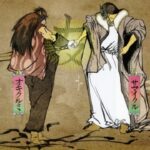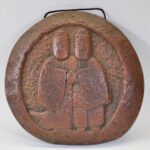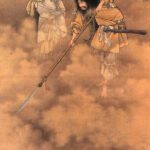Daikoku is one of the most revered deities in Japanese mythology, known primarily as the god of wealth and prosperity. His image is often associated with abundance and happiness, making him a popular figure in various aspects of Japanese culture. He is frequently depicted as a jovial, plump man with a broad smile, a large bag filled with treasures, and a mallet that symbolizes the ability to create wealth. His presence is not only significant in religious practices but also in everyday life, where many people invoke his blessings for good fortune and financial success.
The Origins of Daikoku
The origins of Daikoku can be traced back to ancient Japanese beliefs and practices. He is believed to have roots in Hindu mythology, where he is associated with the deity Mahākāla, a protector of the dharma. Over time, Daikoku was integrated into the Shinto pantheon, where he took on distinct characteristics that resonated with Japanese culture. His transformation reflects the blending of different religious traditions, showcasing how myths evolve and adapt over time. This syncretism is a key aspect of Japanese spirituality, where various influences merge to create a rich tapestry of beliefs.
 Chup Kamui
Chup KamuiIn addition to his Hindu connections, Daikoku is often associated with the Buddhist concept of prosperity. As Buddhism spread throughout Japan, various deities were incorporated into the local belief system, and Daikoku became a prominent figure in this new context. His attributes, such as wealth and abundance, align well with the Buddhist ideal of generosity and compassion. This fusion of influences has helped to solidify his status as a vital figure in both Shinto and Buddhist practices, making him a beloved deity among the Japanese people.
Physical Appearance and Symbols
Daikoku’s physical appearance is one of the most recognizable aspects of his character. He is often depicted as a robust, smiling man with a bald head and a long beard. His joyful expression embodies the spirit of happiness and contentment that he represents. One of his most iconic features is the large bag he carries, which is filled with rice and other treasures. This bag symbolizes abundance and the wealth he bestows upon his followers. Many people believe that by praying to Daikoku, they can receive blessings of prosperity and good fortune.
Another significant symbol associated with Daikoku is his mallet, known as the “uchide no kozuchi.” This magical mallet is said to have the power to bring wealth and good fortune to those who possess it. In artistic representations, Daikoku is often shown holding this mallet, ready to bestow blessings upon the faithful. The mallet also signifies the ability to overcome obstacles and achieve success, reinforcing the idea that prosperity can be attained through hard work and determination.
 Chimata-no-kami
Chimata-no-kamiCommon Symbols of Daikoku
- Bag of Treasures: Represents wealth and abundance.
- Magical Mallet: Symbolizes the power to create prosperity.
- Rice: A symbol of sustenance and nourishment.
- Plump Figure: Represents happiness and contentment.
In addition to these symbols, Daikoku is often depicted alongside other deities, such as Fukurokuju, who represents wisdom and longevity. Together, they form part of the “Seven Lucky Gods,” a group of deities that embody various aspects of fortune and happiness. The imagery of these gods is prevalent in Japanese art, especially during the New Year celebrations, where they are invoked for blessings in the coming year. This interconnectedness among deities highlights the importance of community and shared beliefs in Japanese mythology.
Daikoku in Popular Culture
Daikoku’s influence extends beyond religious practices and into popular culture. His image can be found in various forms of art, from traditional paintings to modern illustrations. He is often portrayed in festivals, where people celebrate his blessings with music, dance, and food. These celebrations are vibrant and joyful, reflecting the happiness that Daikoku represents. Many people also keep small statues or talismans of Daikoku in their homes or businesses to attract good fortune and prosperity.
In addition to traditional representations, Daikoku has also made his way into contemporary media. He appears in video games, anime, and manga, often as a symbol of good luck or as a character that helps others achieve their goals. His popularity in these mediums highlights the enduring appeal of Daikoku as a figure of happiness and prosperity. By incorporating him into modern narratives, creators are able to connect with audiences who may be unfamiliar with traditional Japanese mythology, ensuring that Daikoku’s legacy continues to thrive.
 Kojiki
KojikiWorship and Rituals
Worship of Daikoku often takes place at shrines dedicated to him, where followers come to pray for wealth and good fortune. These shrines are usually adorned with images of Daikoku, and visitors often leave offerings such as rice, sake, or money. The act of giving offerings is a way to show gratitude for the blessings received and to seek further prosperity. Rituals may vary from one shrine to another, but the underlying theme of attracting wealth and abundance remains consistent.
During the New Year, many people visit shrines to pray to Daikoku for blessings in the coming year. This practice is part of a broader tradition of seeking good fortune at the start of the year, known as “Hatsumode.” The first visit to the shrine is considered auspicious, and people often dress in traditional clothing to mark the occasion. This communal aspect of worship reinforces the importance of Daikoku in Japanese culture, as people come together to seek blessings and share in the joy of the New Year.
Ritual Practices Associated with Daikoku
- Offerings: Rice, sake, and money are common offerings made to Daikoku.
- Prayers: Followers often recite prayers asking for wealth and prosperity.
- Hatsumode: The first shrine visit of the year, dedicated to seeking blessings.
- Festivals: Celebrations that honor Daikoku, often involving music and dance.
In addition to shrine visits, many businesses also hold rituals to honor Daikoku, especially at the beginning of the fiscal year. These rituals may involve special ceremonies where employees pray for the success of the company. Such practices highlight the deep connection between Daikoku and the pursuit of economic prosperity in Japanese society. By invoking his blessings, businesses hope to attract customers and ensure a profitable year ahead.
Daikoku and the Seven Lucky Gods
Daikoku is one of the “Seven Lucky Gods,” a group of deities who are believed to bring good fortune and happiness. Each of these gods has unique attributes and areas of influence, but they all share a common goal of promoting prosperity and well-being. The Seven Lucky Gods are celebrated together during various festivals, particularly during the New Year, when people pray for blessings in the year ahead. Daikoku’s presence among these gods reinforces his significance in the realm of wealth and abundance.
Each of the Seven Lucky Gods has its own story and symbolism. For example, Fukurokuju represents wisdom and longevity, while Jurojin embodies long life and happiness. Together, they form a well-rounded pantheon that addresses different aspects of human experience. The interplay between these deities reflects the complexity of Japanese mythology, where multiple narratives coexist and complement each other. Daikoku, as the god of wealth, plays a crucial role in this dynamic, symbolizing the importance of financial stability and abundance in people’s lives.
The Seven Lucky Gods
- Daikoku: God of wealth and prosperity.
- Fukurokuju: God of wisdom and longevity.
- Jurojin: God of long life and happiness.
- Benzaiten: Goddess of knowledge and art.
- Hotei: God of happiness and contentment.
- Ebisu: God of fishermen and good fortune.
- Shōten: God of commerce and trade.
The Seven Lucky Gods are often depicted in art and literature, each with their own unique characteristics and stories. Their images are commonly found in homes and businesses, serving as talismans of good luck. The collective worship of these gods during festivals fosters a sense of community and shared hope among participants. People believe that by honoring these deities together, they can enhance their chances of receiving blessings in various aspects of life, including health, happiness, and financial success.
Daikoku in Art and Literature
Daikoku has been a popular subject in Japanese art and literature for centuries. His joyful demeanor and associations with wealth make him a favorite among artists and writers alike. Traditional woodblock prints often feature Daikoku alongside other deities, showcasing the vibrant and colorful depictions of his character. These artworks not only serve as representations of Daikoku but also reflect the cultural values of abundance and prosperity that he embodies.
In literature, Daikoku is often portrayed as a wise and benevolent figure who helps those in need. Stories about his adventures and interactions with humans emphasize his role as a protector and benefactor. These tales serve to reinforce the idea that hard work and dedication can lead to prosperity, echoing the values that Daikoku represents. Through these narratives, audiences are encouraged to cultivate positive qualities such as generosity and perseverance, further embedding Daikoku’s teachings into the cultural fabric of Japan.
Artistic Representations of Daikoku
- Woodblock Prints: Traditional art forms showcasing Daikoku’s joyful character.
- Paintings: Daikoku is often depicted in colorful and vibrant scenes.
- Literature: Stories highlight his role as a benefactor and protector.
- Festive Decorations: Daikoku’s image is used in New Year celebrations and festivals.
Contemporary artists continue to draw inspiration from Daikoku, reinterpreting his image in modern contexts. This evolution reflects the enduring appeal of his character and the values he represents. By adapting Daikoku’s image to fit contemporary themes, artists can engage with new audiences while preserving the essence of this beloved deity. As a result, Daikoku remains a significant figure not only in traditional Japanese culture but also in the modern artistic landscape.
The Global Influence of Daikoku
While Daikoku is primarily recognized within Japan, his influence has extended beyond its borders. As Japanese culture has gained popularity worldwide, so too has the fascination with its mythology and deities. Daikoku, in particular, has become a symbol of good fortune and prosperity that resonates with people across different cultures. His image can be found in various forms, from statues in homes to representations in art and literature, reflecting the universal appeal of his character.
In addition to his representation in art and culture, Daikoku has also been embraced by various communities around the world. Festivals celebrating Japanese culture often include references to Daikoku, showcasing his significance as a deity of prosperity. This global recognition highlights the interconnectedness of cultures and the ways in which mythology can transcend geographic boundaries. As more people learn about Daikoku and his attributes, his legacy continues to grow, fostering a greater appreciation for Japanese mythology and spirituality.
Daikoku’s Global Presence
- Statues and Figurines: Daikoku is often used as a good luck charm in various cultures.
- Cultural Festivals: Celebrations that honor Japanese heritage often feature Daikoku.
- Art Exhibitions: Modern artists showcase Daikoku in contemporary works.
- Literature and Media: Daikoku appears in various forms of storytelling worldwide.
The growing interest in Japanese culture and mythology has led to an increased understanding of Daikoku’s significance. As more people engage with his story and symbolism, they are drawn to the values of prosperity, happiness, and community that he embodies. This cross-cultural appreciation not only enriches the understanding of Daikoku but also fosters connections between different traditions and beliefs, showcasing the power of mythology to unite people from diverse backgrounds.
Conclusion: The Enduring Legacy of Daikoku
Daikoku’s enduring legacy in Japanese mythology is a testament to the importance of wealth, happiness, and community in human experience. His image and attributes continue to inspire people, reminding them of the potential for prosperity and abundance in their lives. Through rituals, art, and literature, Daikoku’s influence remains strong, ensuring that his teachings and blessings are passed down through generations. As a beloved deity, Daikoku serves as a symbol of hope and good fortune, embodying the values that resonate deeply within Japanese culture and beyond.
